Tunisia hasn’t had it easy, lately. Despite the revolution, though, it’s a tranquil Mediterranean country rife with Roman ruins, Islamic architecture, exquisite food, and a friendly populace who are eager for tourism to resume. Add to this easy air access from Europe and Africa and a spate of new luxury properties. It’s also the only fully democratic sovereign state in the Arab world, and has a high human development index. Tourism is the largest export.
For these reasons, Tunisia makes my list of reemerging destinations.
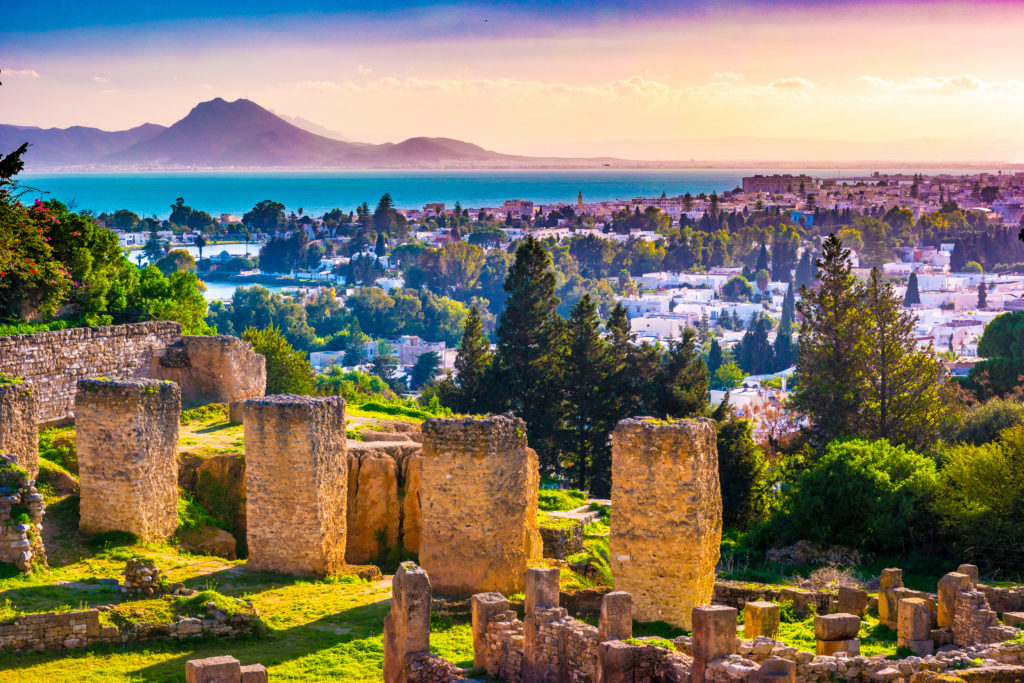
The ruins of Carthage are just outside of Tunis, the capital of Tunisia.
Other reemerging destinations:
Tunisia – Past, Present, Future
Historically, Tunisia is a Berber nation, though today Arab culture dominates. The Phoenicians settled much of the country prior to the Roman invasion in 1BCE. This literate trading civilisation is credited with creating the first widely used writing system. They also founded Carthage, which dominated the Mediterranean in the 1st millennium BCE. From 146 BCE to the mid 7th century, Romans ruled the fertile land. By the end of the 7th century, though, Muslims had conquered, and ruled until the Ottoman Empire in the 16th century. Like much of Africa in the 19th and 20th centuries, Tunisia had a colonial power – France. Tunisia declared independence in 1957.
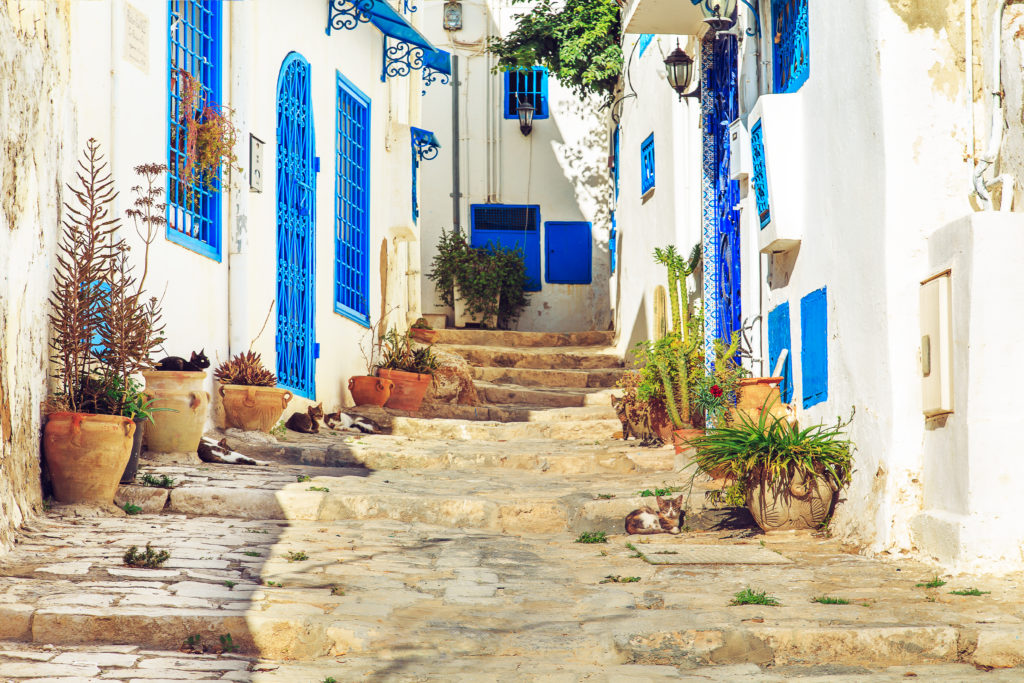
Tunisia’s northern coastal villages have a very Mediterranean feel to them.
In 2011, the Tunisian Revolution sparked the Arab Spring, which resulted in political turmoil across the Middle East. The Tunisian president fled after 23 years in power. In late 2015, two terrorist attacks left 60 dead in Tunis and Sousse. In the same year, though, the Tunisian National Dialogue Quartet won the Nobel Peace Prize for promoting a new political discourse.
Today, tourism is increasing steadily. Freckled with a gorgeous coastline and a rich Saharan interior, Tunisia remains one of the most attractive North African countries to visit. The Tunisian dinar (TND) is worth about a third of the US Dollar, adding incredible value to the destination. I spoke with Sabri Oueslati, owner and operator of Dar to Dar, a destination management company in Tunis to learn more.
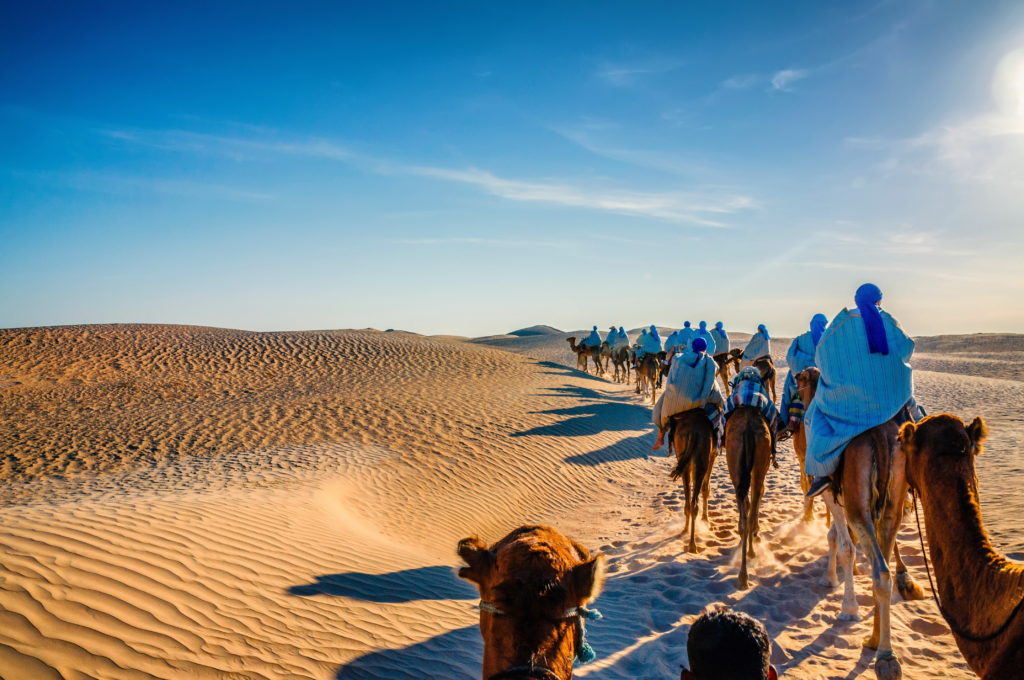
In the Sahara Desert of Tunisia, experiences include camel-riding to a traditional Berber camp.
How to Get To Tunisia
Most of the major air carriers fly to Tunisia. A quick search on the matrix for getting to Tunisia from New York’s JFK yielded results on Egyptair, Delta/Air France, Emirates, Qatar, and Turkish Air through their respective European/Middle Eastern hubs, among others. Tunisair flies nonstop from Montreal; they will fly from New York beginning in 2019 (according to a 2017 report). From the US, Sabri suggests flying through Paris – there are ten flights a day, and it’s a short two-hour flight. From the UK, Thomas Cook and TUI both fly nonstop to Tunis.

Sidi Bou Said is a coastal resort town in Tunisia, popular with tourists and artists.
Tunisia’s Tunis-Carthage International (TUN) is the international gateway to the country; to get from Tunis to other parts of the country, either fly a regional airline, rent a sport utility vehicle, or hire a driver.
Where to Go in Tunisia
Tunis, the capital of Tunisia, is a bustling Arab city, with medinas, mosques, and museums all worth visiting. The ruins of Carthage are about nine miles from the city, while the city’s Bardo Museum is one of the most important museums in both the Med and in Africa. Tunis’s medina, at the core of the ancient city, is a UNESCO World Heritage Site; the modern city’s Art Nouveau buildings and wide boulevards highlight the colonial history of Tunisia.
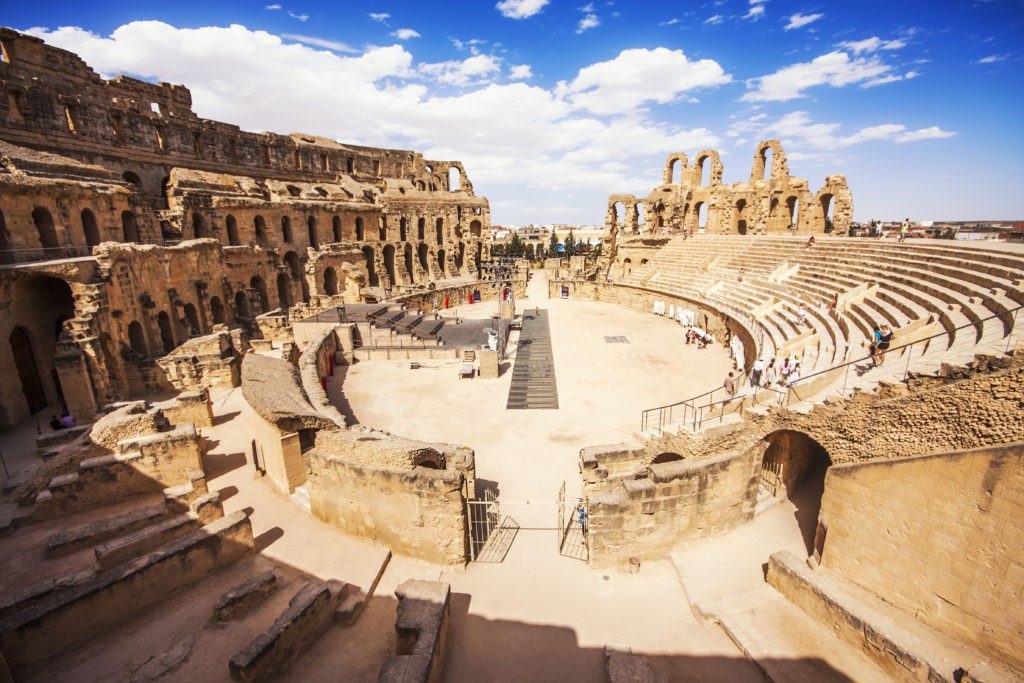
The Roman amphitheatre at El Jem is one of th ancient treasures of Tunisia. Marques / Shutterstock.com
But it’s very easy to get out of the vibrant city and explore the vibrant treasures of Tunisia’s history. From the Roman amphitheatre at El Jem to the Antonine baths at Carthage, the ancient history of Tunisia remains evident. In the late 19th century, when French colonial powers took control of the country, they developed a strong infrastructure that still remains. Tunis’s quickly expanded beyond its fortifications, into what we can see today as the outer suburbs. Nearby picturesque villages like Sidi Bou Said are popular with both artists and tourists.
The coast south of Tunis, near Nabeul and Hammamet, is rife with thalassotherapy spas, Turkish baths, and other health resorts – a popular destination for European visitors.
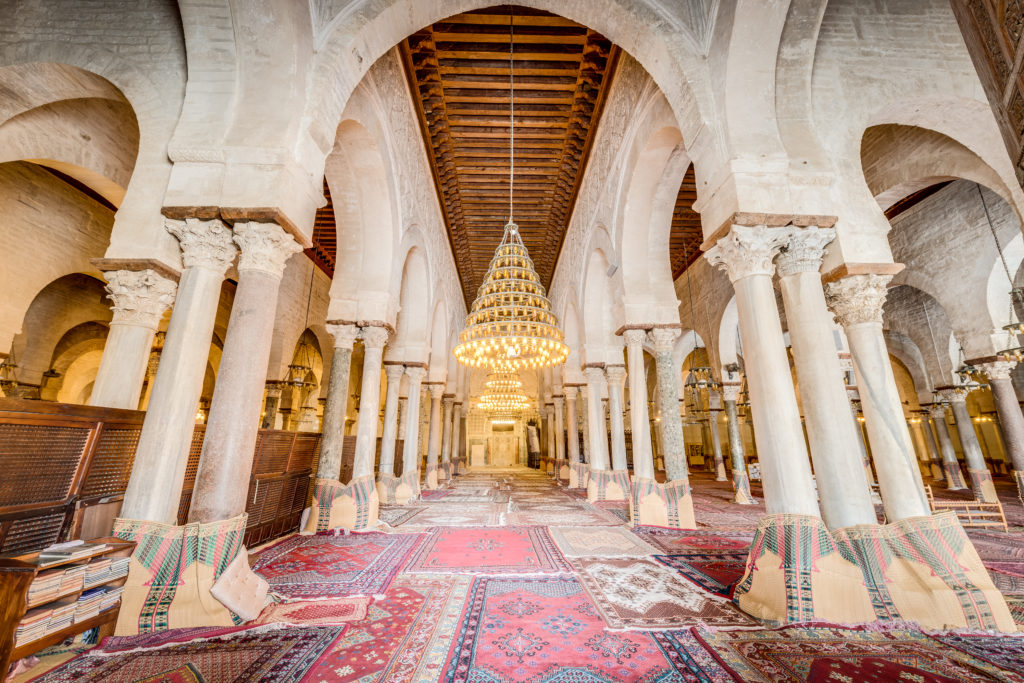
Kairouan’s Great Mosue of Uqba is one of the largest mosques in the Arab world. Anibal Trejo / Shutterstock.com
Kairouan, about 115 miles south of Tunis, is home to an enormous mosque, founded in the 7th century and enlarged under the Aghlabids in the 9th century. Known as the Great Mosque of Kairouan and the Mosque of Uqba, it was also the centre of education and intellectual thought. Scholars have compared its role in both secular and Islamic sciences to that of the University of Paris.
Out of This Galaxy
Further afield, the Atlas Mountains separate the Mediterranean climate from the Saharan Desert. The Berber culture is evident in Tataouine, a Berber city with below-ground dwellings designed for coolness. It is, not surprisingly, a popular spot for filmmakers and cinema fans. The southern Mediterranean island of Djerba is home to both Muslim and Jewish quarters.
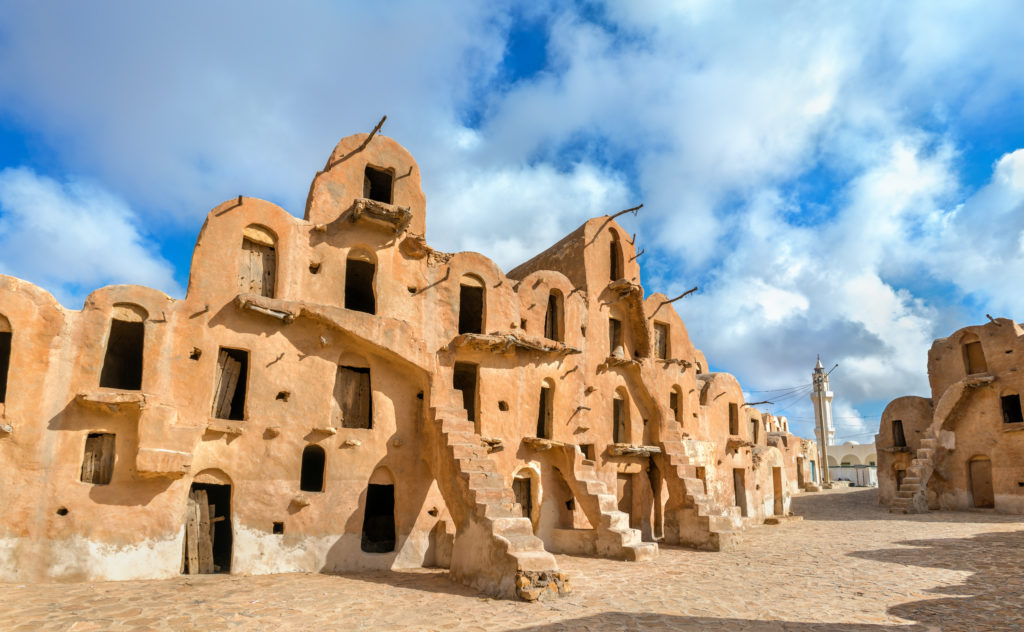
Tunisia’s desert town of Tataouine is popular with filmmakers and tourists – and was the inspiration for a certain film franchise.
Tunisian Experiences
From touring UNESCO World Heritage Sites and sailing the Mediterranean to caving, scuba diving, or wine tasting, Tunisia offers a myriad of experiences for the active and curious traveler. Sabri prepares custom itineraries for clients, based on their interests and budget, so there are plenty of options.
To truly experience the entire country, he recommends at least 10 days to travel between both north and south, although with less time you can choose either or. In the north, experiences range from exploring the Roman ruins to visiting charming coastal villages and immersing yourself in the vibrant culture and history of Roman Africa. Southern experiences often include a visit to Tataouine, the inspiration for Star Wars’ Tatooine planet, camel riding in the desert, and experiencing a traditional Berber village.
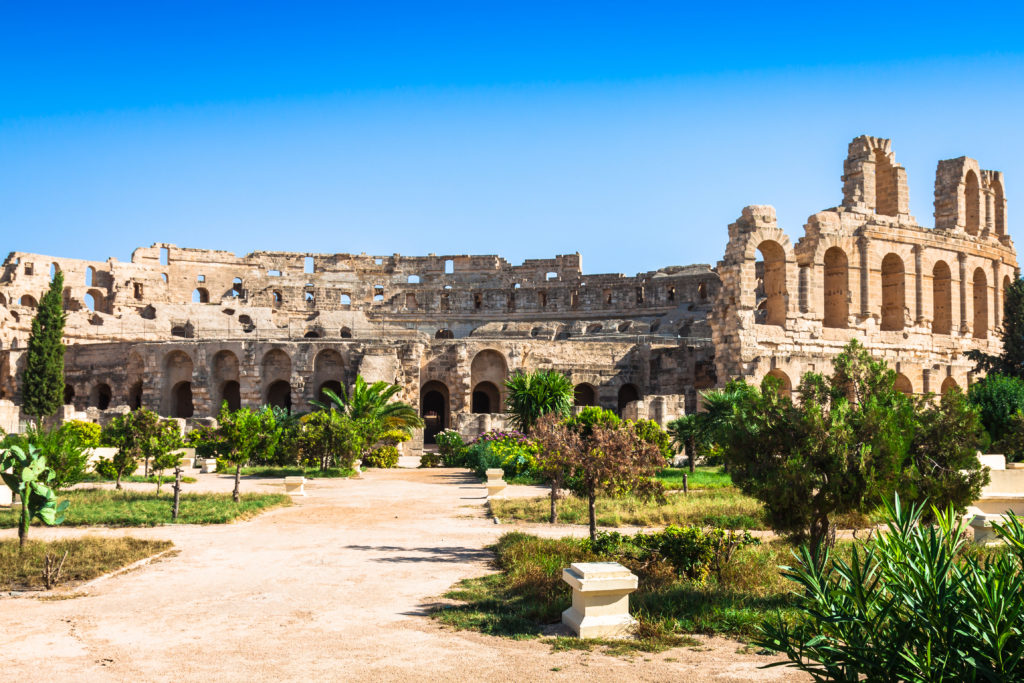
Tunisia’s Roman history is still evident in the many amphitheatres and baths in the country.
The Four Seasons at Gammarth, in Tunis, opened in late 2017, while the Anantara at Tozeur is expected to open in March 2019. As Sabri says, luxurious experiences are different for everyone. Tunisia offers a more rustic and authentic experience to other Middle Eastern/Northern African destinations like Dubai.
Is It Safe? – Yes, and Why Go
After declining drastically in 2011, tourism in Tunisia is back up, and estimates suggest an increase in 25% since 2016. Over eight million tourists are expected to travel to Tunisia in 2018, a 6% increase in 2010 numbers. While this number may seem small – in comparison to the high percentages in tourism revival across Egypt, Turkey, Morocco, and Israel – Sabri said overall, Tunisians are pleased with the numbers. According to Sabri, 2010 marked “normal” tourism numbers. To return to that level after seven years is a very good indicator that Tunisia is back to normal.

Tunisia’s coast is a a gorgeous Mediterranean coast with plenty of resorts.
The highest number of travelers come from Algeria, France, and Russia, while the British are also returning. American travelers are lower on the list, but Tunisia is seeing an increase in American visitors. Sabri thinks this is great, as there is little to no “negative recommendations” and Tunisia is once again seen as safe.

Tunisia is a unique country with plenty of exciting activities.
Tunisia – An Alternative to Morocco
If you’re interested in experiencing a culture that is actively changing, meeting people who are living history as the country changes from a dictatorship to a democracy, then now is the best time to visit Tunisia. Consider Tunisia – and its emerging luxury experiences – as an alternative to Morocco. Similar cultural and historical experiences with a fraction of the visitors and cost.
*
Sarah is a luxury travel advisor and avid traveller. When she isn’t writing for Point Me To The Plane you can find her crafting custom itineraries for clients or exploring the far reaches of our wonderful planet. Read more about her adventures at The Girl With the Map Tattoo.
The responses below are not provided or commissioned by the bank advertiser. Responses have not been reviewed, approved or otherwise endorsed by the bank advertiser. It is not the bank advertiser's responsibility to ensure all posts and/or questions are answered.
11 comments
” The Tunisian dinar (TND) is worth about a third of the US Dollar”
That doesn’t really tell us anything about relative price levels if we don’ know how much things cost in Tunisian Dinars.
Things do seem very cheap there.
https://www.numbeo.com/cost-of-living/in/Tunis
Hi Debbie, thanks for the comment! Yes the dinar is great value compared to the dollar. To compare, the Four Seasons starts at €208 and goes up incrementally through the categories. The FS Casablanca begins at €280, and rates increase much quicker. Compare those to the FS NY or Paris, and the value for a luxury hotel in Tunisia is exceptional against Europe.
A bit of a puff piece, although well written. Did you actually visit? If so, some more personal insights would add some depth to the article. That said, it’s a lovely, hospitable country with English being spoken by a surprisingly large number of people.
Hi Christian, thank you for your comment. Sabri is a Belgian Tunisian living and working (running his own tourism business) in Tunis. I did base quite a bit on what we spoke about, as everything he creates for clients is customised. And yes, English (and French) are spoken by many people in Tunisia.
Tunisair flies nonstop to Tunis from Montreal. So that’s another connection option.
Awesome, that’s a great tidbit. I will add it!
Sorry, but there is no such thing as a Berber “Camp”. The Amazigh were sedentary as the many villages, of which some are still inhabited by Berber speaking their own language (such as Zraoua, Tamezret etc) , show. Unfortunately they are often forgotten in travel agency’s programs.
Hi Rick, thank you for clarifying. I will edit. It seems Berber culture is being embraced in visiting villages and meeting locals: https://www.independent.co.uk/travel/africa/tunisia-berber-villages-heritage-traditional-culture-tamezret-toujane-a8417791.html
Indeed Sarah, that is a great article, well researched by Isabel, who spent quite a few days in the area meeting with locals, off the beaten track.
Neat! Can’t wait to go later this year. Thank you for the overview of places to consider.
Hi Lara, hope you enjoy Tunisia!